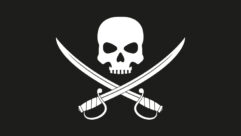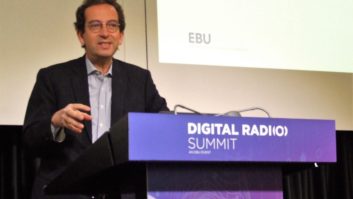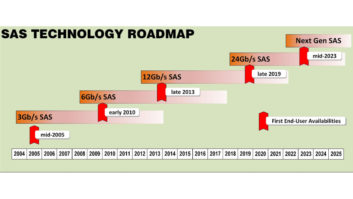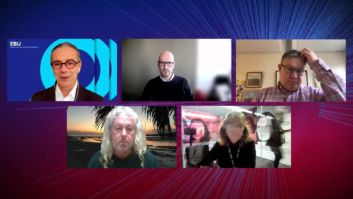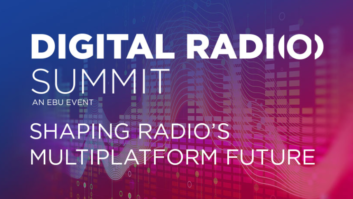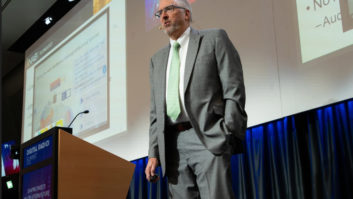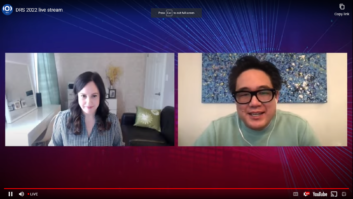
Graham Dixon, EBU head of Radio, presents his
keynote speech at the Digital Radio Summit 2016.
GENEVA — Each year in February the European Broadcasting Union organizes Digital Radio Week, a series of meetings, events and conferences that take place at its headquarters in Geneva. During the week, a public conference, the Digital Radio Summit, also takes place.
MAKING RADIO MODERN
At the 2016 edition, Graham Dixon, EBU head of Radio, presented the keynote speech “Making Radio Modern,” which emphasized that proper DAB implementation won’t be just a technological leap, but it will also have an impact on society in terms of economy.
He pointed out that DAB incurs lower operating costs than both FM and IP technology and provides a foundation for further innovative services, enables specialized programs targeting children, news, niche music and culture, allows for universally affordable and available services that are resilient during emergencies and retains a wide appeal as a hybrid-ready platform. Dixon suggested a new meaning for the acronym DAB: Delivering Audience Benefits.
Richard Robinson, Global Automotive Practice director for Strategy Analytics spoke about the future of media in cars. He noted how the trend in the automotive industry is to aggregate several tasks, which in the past required dedicated devices.
These units often need to access or receive external data, like information to feed onboard safety systems (weather, road status, accidents), vehicle position or to update vehicle software. In his opinion, car manufacturers do not feel comfortable relying exclusively on IP for delivering data to each vehicle, so they are growing increasingly interested in the data capabilities of digital radio.
He stressed the importance of strengthening relationships with car manufacturers because, “user experience with digital radio in car is commonly reported as unsatisfactory.” He went on to say that after further examination of this point, they detected that inadequate user experience was mainly due to “poor implementation of digital radio by the car manufacturer.”
Robinson believes that, since digital radio is still an option in the majority of cases, it is managed as an “extra,” and therefore is “not properly integrated in the rest, maybe difficult to locate or too complicated to use.”
IN-CAR RADIO
Michael Hill, RadioPlayer UK managing director, outlined how in-car listening is and will always be key for the radio industry. Hill pointed out how the streaming service Pandora is now approaching the European market by massively addressing in-car listening. As an example, he played a recent commercial by Pandora.
Hill then unveiled the results of a survey conducted on 1500 people from France, Germany and the United Kingdom who had purchased a new car within the last three years. The purpose was to understand how people feel about in-car radio.

Michael Hill, managing director of Radioplayer UK, revealed the
results of a survey on how people feel about in-car radio during
the Digital Radio Summit. Graphic courtesy Radioplayer UK
“The car industry is marketing any kind of connectivity in the dashboard in their car, with the exception of radio,” he said. “We see no commercial showing radio. But thankfully, there is a radio in any car.”
In each of the discussed countries the market share of car sales by brand is noticeably different, but when it comes to radio listening, consumers from the three countries show nearly the same behaviors with responses being similar across age groups and car types.
Eighty-two percent of new car buyers said they would never consider a car without a radio and 84 percent said they “always” or “mostly” listen to the radio on every journey.
Despite various entertainment options available (CD players, streaming, USB inputs), 74 percent of all listening in modern cars is still radio. When forced to choose a single media to have in their car, 69 percent surveyed said they would choose radio, 11 percent a CD player, 11 percent an MP3 player, 7 percent Bluetooth/smartphone and a bare 1 percent music streaming. The latter being “where car manufacturers have invested a huge amount of money for some years,” Hill pointed out. Full survey results are available at www.radioplayer.co.uk/great-cars-need-great-radios.

Ole Jørgen Torvmark, CEO of Digitalradio Norge
SWITCH-OFF
Ole Jørgen Torvmark, CEO of Digitalradio Norge, told the audience about the Norwegian journey in digital radio. The FM switch-off in Norway will take place in 2017 and according to Torvmark’s figures, about 40 percent of households in Norway do not yet rely on a digital receiver.
“We can’t lose listeners nor listening time,” he said. “So we have to carefully educate people on the opportunities they could lose by not moving to digital radio.” In 2016, communication campaigns on the digital migration switched from “why” to “how” to obtain a digital radio.
The majority of cars already on the market in Norway do not feature a digital receiver, so Digitalradio Norge produced videos to explain how to retrofit their car radio with a digital tuner.
“We don’t have many qualified car radio installers in Norway, so we mainly rely on the ‘do it yourself,’” Torvmark concluded. Norwegian broadcasters have entered into a gentlemen’s agreement to not speak “too much” about the FM switch-off, in particular to focus on its potential rather than the alleged disadvantages.
In the fourth quarter of 2016 communication efforts will focus on “early warning” messages for the forthcoming switch-off. This transition is scheduled to begin in the Nordland region on Jan. 11, 2017 and reach its completion by the end 2017.
The Institut für Rundfunktechnik recently converted the organization’s hybrid radio code for the RasberryPI platform into an Android app. This turns “smart” home radio receivers based on Android ecosystem into fully functional hybrid receivers. In addition, by simply adding a USB digital tuner, these devices can also receive DAB broadcasts. Alexander Erk, of the IRT, provided a demonstration, highlighting how software configuration allows the control of a number of different tuner chipsets through the same app code.
DAB JOINS SMARTPHONES
This year’s big news came from Ronald Haanstra, International DMB Advancement Group vice president. “We had a long battle to convince mobile manufacturers to implement DAB receivers within their smartphones and we finally succeeded,” he said.
He announced that the world’s first DAB+ smartphone would be introduced in Paris at Radiodays Europe in March. The new device (a 5.7-inch mid-range smartphone with an SDK available for building apps) will be available in Europe and Australia for about €299 (around US$330) retail, he added.
Christophe Pasquier, senior sport producer at EBU Radio, addressed the inflation of sports broadcast rights costs prevalent across the market. “Enormous private companies are investing in the business of sports and as a result, public-service televisions are losing key properties,” he said.
Citing an example, he mentioned how on Dec. 21, BBC Sport DirectorBarbara Slater announced the termination of the broadcaster’s TV rights agreement for Formula 1, as a part of the company’s spending review.
Pasquier suggested that public radio broadcasters could secure and strengthen major sporting events coverage through creative usage of their visual radio feature. As possible examples, Pasquier mentioned the BBC’s “Pint-sized Ashes,” an infographic video summary of each day’s cricket matches.
Condensing seven-hours of coverage and action into a two-minute clip, the BBC team used snippets of commentary paired with visual elements, including pictures of on-the-field play, cartoons of a popular commentary team and Twitter comments from ex-players and the general public, to provide a brief, funny and informative digest of all the action.
Also for the purpose of testing the potential of this new form of entertainment, Euroradio produced an “augmented visual” radio feed for three major sport events. The most recent was that of the 2015 Skiing World Championship competition held in Vail, Colorado, and it attracted more than 3 million IP connections to the visual radio stream from all over the world, Pasquier explained.
For this, the EBU developed a visual CMS to ingest and rapidly publish graphically pleasing data from Swiss Timing as well as content from social media platforms like Twitter or Instagram. Tailor-made images were selected and pushed live using the CMS to create a visual stream made available to broadcasters to use on both their digital radio services and on their websites.
EBU Senior Project Manager Mathias Coinchon wrapped up the conference by reiterating an important phrase — “compete on content, cooperate on technology” — as a guideline for all radio industry professionals.
Davide Moro reports on the industry for Radio World from Bergamo, Italy.




